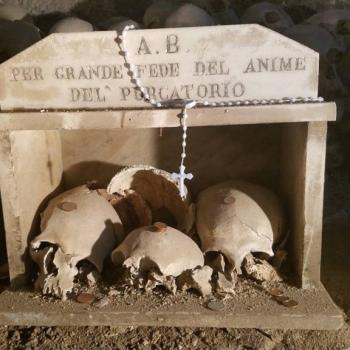Practically unknown in Mexico before the 1980s, Saint Jude Thaddeus has catapulted to the top position among Catholic saints in the country with the world’s second largest Catholic population, which will soon surpass Brazil for the top spot. No other Catholic saint rivals the popularity of San Judas. Only the Virgin of Guadalupe and folk saint Santa Muerte can compete with St. Jude for Mexican souls. And over the past two decades, competition between the nation’s number one Catholic saint and its top folk saint has become very intense, to the point that St. Jude in Mexico is now the only Catholic saint in the world who has a monthly feast day, on each 28th day!
Until two decades ago, the green and white cloaked saint had only an annual feast day — October 28 — exactly like his thousands of fellow Catholic counterparts around the world. However, the unexpected emergence of Santa Muerte, a vernacular saint personifying death, changed everything. The Bony Lady (one of her popular nicknames) is not only the fastest growing New Religious Movement in Mexico but also on the entire planet with an estimated 12 million devotees, the great majority only since 2002. Just a few miles down the road from the famous St. Jude shrine in Mexico City at the San Hipolito Church, Santa Muerte devotional pioneer Enriqueta Romero (affectionately known as Doña Queta) for two decades now has been holding a monthly rosary service dedicated to the skeleton saint.
In fact, on this Halloween of 2024 she will celebrate the 23rd anniversary of setting her life-size effigy of the Bony Lady out on the sidewalk in front of her home in the notorious Mexico City barrio of Tepito. As related to me by the rector of the Saint Jude shrine, it was in response to new competition from the saint of death that enterprising priests at San Hipolito Church decided to initiate St. Jude feasts, celebrated on the 28th of each month.
The monthly, and especially annual, celebrations of the patron of lost causes are wildly colorful affairs with devotees from all walks of Mexican life, but especially the working classes, lugging life-sized statues of the saint of last resorts, and many others dressed in his signature green and white garb, which are two of the three colors of the Mexican flag. In other countries the patron of lost causes is dressed in different colors, which don’t usually correspond to those of national flags.
What really stands out at the annual and monthly fiestas attended by thousands, which I have participated in on several occasions, is the presence of marginalized Millennials and Generation Zers, hundreds of whom smoke marijuana and huff glue on the sidewalks that abut the temple. Ironically, the saint who is depicted with the flame of the Holy Spirit on his forehead, also has a reputation for healing drug abusers. In fact, this has been an important part of the ministry at San Hipolito Church, which promotes a line of Saint Jude mineral water in a city suffering from a severe water shortage.
The strong contingent of marginalized youth and even criminals makes San Judas every bit as fascinating as the skeleton saint down the road. In theory, one of Santa Muerte’s strong appeals is that since she isn’t a Catholic saint, some devotees feel freer in asking her for unsavory favors. However, it turns out that even though he is a canonized saint, Jude is also often asked to perform miracles that don’t square with Christian standards of morality. During a recent visit to a Catholic church in the capital city of Oaxaca I spotted a photograph of a presumed narco brandishing a semi-automatic rifle which had been affixed to the St. Jude shrine in the sanctuary.


This has become of such concern to the Catholic Church that in 2008 the Archdiocese of Mexico City released a statement warning against such unorthodox practices. One such unorthodoxy is the common belief by more than a few devotees that when the most popular Catholic saint in Mexico is represented with the iconic staff in his left hand, he is open to left-handed prayers and petitions that he would never consider with the staff at his right. The patron of lost cause’s unique ability to function as both Catholic and folk saint has facilitated his meteoric rise on the Mexican religious landscape over the past four decades.













